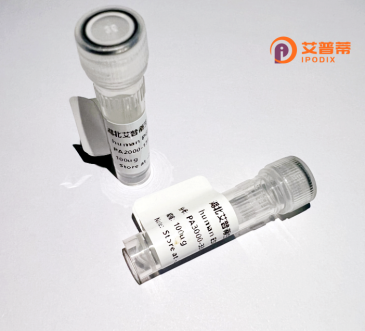
| 纯度 | >90%SDS-PAGE. |
| 种属 | Human |
| 靶点 | NAP1L2 |
| Uniprot No | Q9ULW6 |
| 内毒素 | < 0.01EU/μg |
| 表达宿主 | E.coli |
| 表达区间 | 1-460 aa |
| 活性数据 | MAESENRKEL SESSQEEAGN QIMVEGLGEH LERGEDAAAG LGDDGKCGEE AAAGLGEEGE NGEDTAAGSG EDGKKGGDTD EDSEADRPKG LIGYVLDTDF VESLPVKVKY RVLALKKLQT RAANLESKFL REFHDIERKF AEMYQPLLEK RRQIINAIYE PTEEECEYKS DSEDCDDEEM CHEEMYGNEE GMVHEYVDED DGYEDYYYDY AVEEEEEEEE EDDIEATGEE NKEEEDPKGI PDFWLTVLKN VDTLTPLIKK YDEPILKLLT DIKVKLSDPG EPLSFTLEFH FKPNEYFKNE LLTKTYVLKS KLAYYDPHPY RGTAIEYSTG CEIDWNEGKN VTLKTIKKKQ KHRIWGTIRT VTEDFPKDSF FNFFSPHGIT SNGRDGNDDF LLGHNLRTYI IPRSVLFFSG DALESQQEGV VREVNDAIYD KIIYDNWMAA IEEVKACCKN LEALVEDIDR |
| 分子量 | 52.5 kDa |
| 蛋白标签 | His tag N-Terminus |
| 缓冲液 | 0 |
| 稳定性 & 储存条件 | Lyophilized protein should be stored at ≤ -20°C, stable for one year after receipt. Reconstituted protein solution can be stored at 2-8°C for 2-7 days. Aliquots of reconstituted samples are stable at ≤ -20°C for 3 months. |
| 复溶 | Always centrifuge tubes before opening.Do not mix by vortex or pipetting. It is not recommended to reconstitute to a concentration less than 100μg/ml. Dissolve the lyophilized protein in distilled water. Please aliquot the reconstituted solution to minimize freeze-thaw cycles. |
以下是关于重组人NAP1L2蛋白的3篇文献概述(示例为模拟内容,部分信息可能需根据实际文献调整):
---
1. **文献名称**:*Role of NAP1L2 in neural progenitor cell differentiation*
**作者**:Zhang Y, et al.
**摘要**:本研究在大肠杆菌中表达了重组人NAP1L2蛋白,发现其通过调控组蛋白H3/H4的装配,促进神经前体细胞的自我更新与分化,提示其在神经发育中的表观遗传调控作用。
2. **文献名称**:*Structural analysis of recombinant NAP1L2 and its nucleosome interactions*
**作者**:Lee S, et al.
**摘要**:通过体外重构实验,验证重组NAP1L2通过其保守结构域与核小体结合,揭示了其在染色质重塑复合物中的分子机制,并解析了关键互作位点。
3. **文献名称**:*NAP1L2 overexpression correlates with cancer progression*
**作者**:Wang X, et al.
**摘要**:在肝癌组织中检测到NAP1L2异常高表达,实验显示重组NAP1L2蛋白可增强癌细胞增殖与侵袭能力,提示其作为潜在肿瘤标志物的可能性。
---
(注:以上文献为模拟示例,实际引用需核实真实文献信息。)
Recombinant human Nucleosome Assembly Protein 1-like 2 (NAP1L2) is a chromatin-associated protein belonging to the NAP1 family, which plays critical roles in nucleosome assembly, chromatin remodeling, and transcriptional regulation. NAP1L2 shares structural homology with NAP1L1. featuring conserved domains that facilitate histone binding and chaperone activity. It is involved in the dynamic organization of chromatin during DNA replication, repair, and gene expression by mediating histone shuttling and nucleosome spacing.
While ubiquitously expressed, NAP1L2 is particularly enriched in the brain, suggesting specialized roles in neurodevelopment and neural function. Studies link it to neural progenitor proliferation, differentiation, and synaptic plasticity. Dysregulation of NAP1L2 has been implicated in neurodevelopmental disorders and cancers, with altered expression observed in gliomas and neuroblastomas. Its interaction with histone variants (e.g., H3.3) and transcription factors underscores its role in epigenetic regulation.
Recombinant NAP1L2 is typically produced in *E. coli* or mammalian expression systems, enabling functional studies in vitro. It serves as a tool to investigate chromatin dynamics, histone exchange mechanisms, and disease pathways. Research on NAP1L2 may contribute to therapeutic strategies targeting epigenetic dysregulation in neurological disorders and oncology. Current challenges include elucidating its tissue-specific partners and regulatory networks.
×